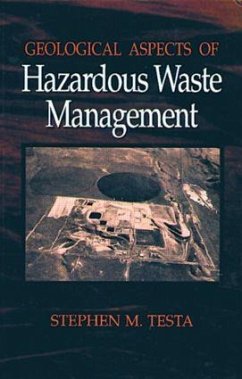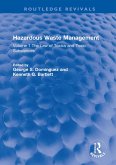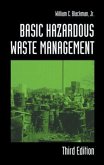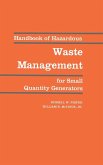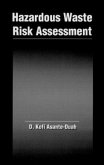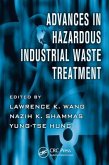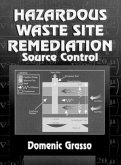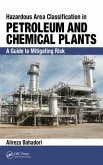Stephen M. Testa
Geological Aspects of Hazardous Waste Management
Stephen M. Testa
Geological Aspects of Hazardous Waste Management
- Gebundenes Buch
- Merkliste
- Auf die Merkliste
- Bewerten Bewerten
- Teilen
- Produkt teilen
- Produkterinnerung
- Produkterinnerung
Geologic Aspects of Hazardous Waste Management brings together technical, legislative, regulatory, and business aspects of hazardous waste issues as they pertain to preventing, assessing, containing, and remediating soil and groundwater contamination. The book emphasizes how subsurface geologic and hydrogeologic conditions affect the decision-making process, and it focuses on critical issues facing industry, government, and the public. The book is excellent for consultants, project managers, regulators, geologists, geophysicists, hydrologists, hydrogeologists, risk assessors, environmental engineers, chemists, toxicologists, and environmental lawyers.…mehr
Andere Kunden interessierten sich auch für
![Hazardous Waste Management Hazardous Waste Management]() Hazardous Waste Management217,99 €
Hazardous Waste Management217,99 €![Basic Hazardous Waste Management Basic Hazardous Waste Management]() Jr. William C. BlackmanBasic Hazardous Waste Management250,99 €
Jr. William C. BlackmanBasic Hazardous Waste Management250,99 €![Handbook of Hazardous Waste Management for Small Quantity Generators Handbook of Hazardous Waste Management for Small Quantity Generators]() Russell W. PhiferHandbook of Hazardous Waste Management for Small Quantity Generators377,99 €
Russell W. PhiferHandbook of Hazardous Waste Management for Small Quantity Generators377,99 €![Hazardous Waste Risk Assessment Hazardous Waste Risk Assessment]() Kofi Asante-DuahHazardous Waste Risk Assessment378,99 €
Kofi Asante-DuahHazardous Waste Risk Assessment378,99 €![Advances in Hazardous Industrial Waste Treatment Advances in Hazardous Industrial Waste Treatment]() Advances in Hazardous Industrial Waste Treatment215,99 €
Advances in Hazardous Industrial Waste Treatment215,99 €![Hazardous Waste Site Remediation Hazardous Waste Site Remediation]() Domenic GrassoHazardous Waste Site Remediation257,99 €
Domenic GrassoHazardous Waste Site Remediation257,99 €![Hazardous Area Classification in Petroleum and Chemical Plants Hazardous Area Classification in Petroleum and Chemical Plants]() Alireza BahadoriHazardous Area Classification in Petroleum and Chemical Plants272,99 €
Alireza BahadoriHazardous Area Classification in Petroleum and Chemical Plants272,99 €-
-
-
Geologic Aspects of Hazardous Waste Management brings together technical, legislative, regulatory, and business aspects of hazardous waste issues as they pertain to preventing, assessing, containing, and remediating soil and groundwater contamination. The book emphasizes how subsurface geologic and hydrogeologic conditions affect the decision-making process, and it focuses on critical issues facing industry, government, and the public. The book is excellent for consultants, project managers, regulators, geologists, geophysicists, hydrologists, hydrogeologists, risk assessors, environmental engineers, chemists, toxicologists, and environmental lawyers.
Hinweis: Dieser Artikel kann nur an eine deutsche Lieferadresse ausgeliefert werden.
Hinweis: Dieser Artikel kann nur an eine deutsche Lieferadresse ausgeliefert werden.
Produktdetails
- Produktdetails
- Verlag: CRC Press
- Seitenzahl: 560
- Erscheinungstermin: 18. November 1993
- Englisch
- Abmessung: 235mm x 157mm x 37mm
- Gewicht: 1050g
- ISBN-13: 9780873716307
- ISBN-10: 0873716302
- Artikelnr.: 21304460
- Herstellerkennzeichnung
- Libri GmbH
- Europaallee 1
- 36244 Bad Hersfeld
- gpsr@libri.de
- Verlag: CRC Press
- Seitenzahl: 560
- Erscheinungstermin: 18. November 1993
- Englisch
- Abmessung: 235mm x 157mm x 37mm
- Gewicht: 1050g
- ISBN-13: 9780873716307
- ISBN-10: 0873716302
- Artikelnr.: 21304460
- Herstellerkennzeichnung
- Libri GmbH
- Europaallee 1
- 36244 Bad Hersfeld
- gpsr@libri.de
Stephen M. Testa is president and founder of Applied Environmental Services, Inc., located in San Juan Capistrano, California. He received his B.S. and M.S. in Geology from California State University at Northridge. For the past 17 years, he has worked in the areas of geology, hydrogeology, engineering geology, and hazardous waste management with firms such as Bechtel, Inc., Converse Consultants, Dames and Moore, and Engineering Enterprises, Inc. He has participated in numerous subsurface hydrogeologic site characterization projects associated with nuclear hydroelectric power and petrochemical plants, hazardous waste disposal facilities, and other industrial and commercial complexes. For the past five years, his main emphasis has been in the area of nonaqueous phase liquid hydrocarbon recovery and aquifer restoration. Maintaining overall management and technical responsibilities in engineering geology, hydrogeology, and hazardous waste-related projects, he has participated in numerous projects involving geologic and hydrogeologic site assessments, soil and water quality assessments, soil remediation, design and development of groundwater monitoring and aquifer remediation programs, waste minimization and recycling, and expert testimony. Mr. Testa is the author of three books and more than 60 technical papers. He is an active member of numerous organizations including the American Association for the Advancement of Science, Association of Engineering Geologists, American Association of Petroleum Geologists, Association of Groundwater Scientists and Engineers, Hazardous Materials Control Research Institute, Geological Society of America, California Groundwater Association, and Sigma Xi. He is also a member of the American Institute of Professional Geologists, where he has served on the Executive Committee and on various committees, including the National Committee for Professional Development, Continuing Education and Screening. He also conducts workshops on various environmental topics and teaches part-time at the University of Southern California and California State University at Fullerton.
CONTENTS
Chapter
1 Introduction
The Waste Problem
Waste Disposal Alternatives
The Role of the Geologist
Bibliography
Chapter
2 Regulatory Framework
Introduction
National Environmental Policy Act (NEPA)
Clean Water Act (CWA)
Safe Drinking Water Act (SDWA)
Drinking Water Standards
Underground Injection Control (UIC) Program
Sole Source Aquifers (SSA)
Toxic Substance Control Act (TSCA)
Resource Conservation and Recovery Act (RCRA)
Hazardous and Toxic Wastes
Mining Wastes
Comprehensive Environmental Response, Compensation, and Liability Act (CERCLA)
Remedial Investigation /Feasibility Study
Environmental Site Assessments
Oil
Field Properties
Geothermal Properties
Bibliography
Chapter
3 Geologic Principles
Introduction
Porosity, Permeability, and Diagenesis
Sedimentary Sequences and Facies Architecture
Fluvial Sequences
Alluvial Fan Sequences
Deltaic Sequences
Glacial Sequences
Eolian Sequences
Carbonate Sequences
Volcanic
Sedimentary Sequences
Structural Style and Framework
Faults
Fractured Media
Seismicity
Bibliography
Chapter
4 Hydrogeologic Principles
Introduction
The Flux Equation
Darcy's Law
Fick's Law
Gases and Vapors
Saturated Systems
Types of Aquifers
Steady State Flow
Nonsteady Flow
Unsaturated Systems
Capillary Barriers
Groundwater Chemistry
Bibliography
Chapter
5 Techniques for Subsurface Characterization
Introduction
Subsurface Exploration
Soil and Rock Borings
Hollow
Stem Auger Drilling
Cable
Tool Drilling
Rotary Drilling
Wire
Line Coring
Horizontal Drilling
Monitoring Wells and Piezometers
Vapor Wells
Cone Penetration Testing
Classification of Subsurface Materials
Unconsolidated Deposits
Unified Soil Classification System
Burmister Soil Identification System
Comprehensive Soil Classification System
Other Pertinent Soil Information
Consolidated Deposits
Soil Vapor Monitoring
Boring Logs and Well Construction Details
Boring Logs
Well Construction Details
Soil Vapor Monitoring
Bibliography
Chapter
6 Geophysical Applications
Introduction
Surface Geophysical Techniques
Ground Penetrating Radar
Electromagnetic Induction
Resistivity
Seismic
Gravity
Magnetometry
Downhole Geophysical Techniques
Nuclear Logs
Natural Gamma Logs
Gamma
Spectrometry Logs
Gamma
Gamma Logs
Neutron
Epithermal Neutron Logs
Other Nuclear Logs
Electric Logs
Resistivity Logs
Spontaneous
Potential Logs
Dipmeter Logs
Fluid Logs
Conductivity Logs
Flow Logs
Temperature Logs
Caliper Logs
Acoustic Logs
Acoustic
Velocity Logs
Acoustic Wave
Form Logs
Cement
Bond Logs
Acoustic
Televiewer Logs
Bibliography
Chapter
7 Waste Characterization
Introduction
Waste Characterization
Soil as a Hazardous Waste
Groundwater as a Hazardous Waste
Selection of Maximum Contaminant Levels and Goals
Crude Oil
Debris Rule
Declassification
Bibliography
Chapter
8 Subsurface Processes
Introduction
Physical Processes
Advection
Dispersion
Diffusion
Volatilization
Filtration
Biological Processes
Subsurface Organisms
Nutrition, Energy, and Cell Metabolism
Enzymes, DNA, and Plasmids
The Bacterial Cell and Biological Processes
Biodegradation of Xenobiotics
Biovolatilization
Bioassimilation and Bioaccumulation
Biomineralization
Chemical Processes
Solute Concentrations in Natural Waters
Chemical Equilibria
Henry's Law and Dissolved Gases
Dissociation
Acid /Base Reactions
Dissolution /Precipitation
Hydrolysis
Oxidation /Reduction (Redox)
Complexation
The Carbonate System
Speciation
Thermal Degradation
Photochemical Reactions
Ion Exchange and Sorption
Retardation Factors
Bibliography
Chapter
9 Nonaqueous Phase Liquids
Introduction
Properties of NAPLs
Light Nonaqueous Phase Liquids
LNAPL Apparent vs Actual Thickness
LNAPL Recovery Considerations
Dense Nonaqueous Phase Liquids
DNAPL Apparent vs Actual Thickness
DNAPL Recovery Considerations
Source Identification
Bibliography
Chapter
10 Landfill Disposal
Introduction
Landfill Design
Liner System
Leachate Collection and Removal System
Siting Criteria
Vadose Detection Monitoring
Lysimeters
Neutron Moisture Probes
Groundwater Detection Monitoring
Point of Compliance
Well Placement
Parametric Studies
Case Histories
Arlington Facility, North
Central Oregon
Site Description
Facility Layout and Operation
Geologic Setting
Hydrogeologic Setting
Groundwater Monitoring System Design
Casmalia Resources Facility, Southern California
Site Description
Facility Layout and Operation
Geologic Setting
Hydrogeologic Setting
Groundwater Monitoring System Design
Bibliography
Chapter
11 Underground Injection
Introduction
Classes of Injection Wells
Class I Wells
Class II Wells
Class III Wells
Class IV Wells
Class V Wells
Siting Criteria
Designation of Underground Sources of Drinking Water
Aquifer Exemption
Hydrogeologic Considerations
Injection Zone Characteristics
Confining Zone Characteristics
Area of Review
Design Criteria
Reporting and Monitoring
Geochemical Fate of Injected Hazardous Waste
Bibliography
Chapter
12 Underground Geologic Repositories
Introduction
Siting Criteria
Host Rock Types
Rock Salt
Granite
Basalts
Volcanic Tuffs
Sedimentary Rocks
Design Considerations
Existing Mines
Solution
Mined Caverns
Mining Methods
Rock Mechanics
Newly Mined Space
Bibliography
Chapter
13 Ocean Disposal
Introduction
Types of Ocean Waste
Dredged Materials
Sewage Sludge
Industrial Wastes
Construction Debris
Incineration Residue Waste
Other Waste Types
The Ocean Environment
Continental Margins
Continental Shelf
Continental Slope
Shelfbreak
Continental Rise
Deep Ocean Regimes
Abyssal Plains
Abyssal Hills
Ocean Processes
Physical Processes
Chemical Processes
Biological Processes
Geologic Considerations
Stability and Predictability
Sediment Properties
Sediment Processes
Bibliography
Appendices
A Conversions for International System (SI Metric) and United States Units
B Glossary of Regulatory Terms of Geologic Significance
C Analysis Reference Chart
Index.
Chapter
1 Introduction
The Waste Problem
Waste Disposal Alternatives
The Role of the Geologist
Bibliography
Chapter
2 Regulatory Framework
Introduction
National Environmental Policy Act (NEPA)
Clean Water Act (CWA)
Safe Drinking Water Act (SDWA)
Drinking Water Standards
Underground Injection Control (UIC) Program
Sole Source Aquifers (SSA)
Toxic Substance Control Act (TSCA)
Resource Conservation and Recovery Act (RCRA)
Hazardous and Toxic Wastes
Mining Wastes
Comprehensive Environmental Response, Compensation, and Liability Act (CERCLA)
Remedial Investigation /Feasibility Study
Environmental Site Assessments
Oil
Field Properties
Geothermal Properties
Bibliography
Chapter
3 Geologic Principles
Introduction
Porosity, Permeability, and Diagenesis
Sedimentary Sequences and Facies Architecture
Fluvial Sequences
Alluvial Fan Sequences
Deltaic Sequences
Glacial Sequences
Eolian Sequences
Carbonate Sequences
Volcanic
Sedimentary Sequences
Structural Style and Framework
Faults
Fractured Media
Seismicity
Bibliography
Chapter
4 Hydrogeologic Principles
Introduction
The Flux Equation
Darcy's Law
Fick's Law
Gases and Vapors
Saturated Systems
Types of Aquifers
Steady State Flow
Nonsteady Flow
Unsaturated Systems
Capillary Barriers
Groundwater Chemistry
Bibliography
Chapter
5 Techniques for Subsurface Characterization
Introduction
Subsurface Exploration
Soil and Rock Borings
Hollow
Stem Auger Drilling
Cable
Tool Drilling
Rotary Drilling
Wire
Line Coring
Horizontal Drilling
Monitoring Wells and Piezometers
Vapor Wells
Cone Penetration Testing
Classification of Subsurface Materials
Unconsolidated Deposits
Unified Soil Classification System
Burmister Soil Identification System
Comprehensive Soil Classification System
Other Pertinent Soil Information
Consolidated Deposits
Soil Vapor Monitoring
Boring Logs and Well Construction Details
Boring Logs
Well Construction Details
Soil Vapor Monitoring
Bibliography
Chapter
6 Geophysical Applications
Introduction
Surface Geophysical Techniques
Ground Penetrating Radar
Electromagnetic Induction
Resistivity
Seismic
Gravity
Magnetometry
Downhole Geophysical Techniques
Nuclear Logs
Natural Gamma Logs
Gamma
Spectrometry Logs
Gamma
Gamma Logs
Neutron
Epithermal Neutron Logs
Other Nuclear Logs
Electric Logs
Resistivity Logs
Spontaneous
Potential Logs
Dipmeter Logs
Fluid Logs
Conductivity Logs
Flow Logs
Temperature Logs
Caliper Logs
Acoustic Logs
Acoustic
Velocity Logs
Acoustic Wave
Form Logs
Cement
Bond Logs
Acoustic
Televiewer Logs
Bibliography
Chapter
7 Waste Characterization
Introduction
Waste Characterization
Soil as a Hazardous Waste
Groundwater as a Hazardous Waste
Selection of Maximum Contaminant Levels and Goals
Crude Oil
Debris Rule
Declassification
Bibliography
Chapter
8 Subsurface Processes
Introduction
Physical Processes
Advection
Dispersion
Diffusion
Volatilization
Filtration
Biological Processes
Subsurface Organisms
Nutrition, Energy, and Cell Metabolism
Enzymes, DNA, and Plasmids
The Bacterial Cell and Biological Processes
Biodegradation of Xenobiotics
Biovolatilization
Bioassimilation and Bioaccumulation
Biomineralization
Chemical Processes
Solute Concentrations in Natural Waters
Chemical Equilibria
Henry's Law and Dissolved Gases
Dissociation
Acid /Base Reactions
Dissolution /Precipitation
Hydrolysis
Oxidation /Reduction (Redox)
Complexation
The Carbonate System
Speciation
Thermal Degradation
Photochemical Reactions
Ion Exchange and Sorption
Retardation Factors
Bibliography
Chapter
9 Nonaqueous Phase Liquids
Introduction
Properties of NAPLs
Light Nonaqueous Phase Liquids
LNAPL Apparent vs Actual Thickness
LNAPL Recovery Considerations
Dense Nonaqueous Phase Liquids
DNAPL Apparent vs Actual Thickness
DNAPL Recovery Considerations
Source Identification
Bibliography
Chapter
10 Landfill Disposal
Introduction
Landfill Design
Liner System
Leachate Collection and Removal System
Siting Criteria
Vadose Detection Monitoring
Lysimeters
Neutron Moisture Probes
Groundwater Detection Monitoring
Point of Compliance
Well Placement
Parametric Studies
Case Histories
Arlington Facility, North
Central Oregon
Site Description
Facility Layout and Operation
Geologic Setting
Hydrogeologic Setting
Groundwater Monitoring System Design
Casmalia Resources Facility, Southern California
Site Description
Facility Layout and Operation
Geologic Setting
Hydrogeologic Setting
Groundwater Monitoring System Design
Bibliography
Chapter
11 Underground Injection
Introduction
Classes of Injection Wells
Class I Wells
Class II Wells
Class III Wells
Class IV Wells
Class V Wells
Siting Criteria
Designation of Underground Sources of Drinking Water
Aquifer Exemption
Hydrogeologic Considerations
Injection Zone Characteristics
Confining Zone Characteristics
Area of Review
Design Criteria
Reporting and Monitoring
Geochemical Fate of Injected Hazardous Waste
Bibliography
Chapter
12 Underground Geologic Repositories
Introduction
Siting Criteria
Host Rock Types
Rock Salt
Granite
Basalts
Volcanic Tuffs
Sedimentary Rocks
Design Considerations
Existing Mines
Solution
Mined Caverns
Mining Methods
Rock Mechanics
Newly Mined Space
Bibliography
Chapter
13 Ocean Disposal
Introduction
Types of Ocean Waste
Dredged Materials
Sewage Sludge
Industrial Wastes
Construction Debris
Incineration Residue Waste
Other Waste Types
The Ocean Environment
Continental Margins
Continental Shelf
Continental Slope
Shelfbreak
Continental Rise
Deep Ocean Regimes
Abyssal Plains
Abyssal Hills
Ocean Processes
Physical Processes
Chemical Processes
Biological Processes
Geologic Considerations
Stability and Predictability
Sediment Properties
Sediment Processes
Bibliography
Appendices
A Conversions for International System (SI Metric) and United States Units
B Glossary of Regulatory Terms of Geologic Significance
C Analysis Reference Chart
Index.
CONTENTS
Chapter
1 Introduction
The Waste Problem
Waste Disposal Alternatives
The Role of the Geologist
Bibliography
Chapter
2 Regulatory Framework
Introduction
National Environmental Policy Act (NEPA)
Clean Water Act (CWA)
Safe Drinking Water Act (SDWA)
Drinking Water Standards
Underground Injection Control (UIC) Program
Sole Source Aquifers (SSA)
Toxic Substance Control Act (TSCA)
Resource Conservation and Recovery Act (RCRA)
Hazardous and Toxic Wastes
Mining Wastes
Comprehensive Environmental Response, Compensation, and Liability Act (CERCLA)
Remedial Investigation /Feasibility Study
Environmental Site Assessments
Oil
Field Properties
Geothermal Properties
Bibliography
Chapter
3 Geologic Principles
Introduction
Porosity, Permeability, and Diagenesis
Sedimentary Sequences and Facies Architecture
Fluvial Sequences
Alluvial Fan Sequences
Deltaic Sequences
Glacial Sequences
Eolian Sequences
Carbonate Sequences
Volcanic
Sedimentary Sequences
Structural Style and Framework
Faults
Fractured Media
Seismicity
Bibliography
Chapter
4 Hydrogeologic Principles
Introduction
The Flux Equation
Darcy's Law
Fick's Law
Gases and Vapors
Saturated Systems
Types of Aquifers
Steady State Flow
Nonsteady Flow
Unsaturated Systems
Capillary Barriers
Groundwater Chemistry
Bibliography
Chapter
5 Techniques for Subsurface Characterization
Introduction
Subsurface Exploration
Soil and Rock Borings
Hollow
Stem Auger Drilling
Cable
Tool Drilling
Rotary Drilling
Wire
Line Coring
Horizontal Drilling
Monitoring Wells and Piezometers
Vapor Wells
Cone Penetration Testing
Classification of Subsurface Materials
Unconsolidated Deposits
Unified Soil Classification System
Burmister Soil Identification System
Comprehensive Soil Classification System
Other Pertinent Soil Information
Consolidated Deposits
Soil Vapor Monitoring
Boring Logs and Well Construction Details
Boring Logs
Well Construction Details
Soil Vapor Monitoring
Bibliography
Chapter
6 Geophysical Applications
Introduction
Surface Geophysical Techniques
Ground Penetrating Radar
Electromagnetic Induction
Resistivity
Seismic
Gravity
Magnetometry
Downhole Geophysical Techniques
Nuclear Logs
Natural Gamma Logs
Gamma
Spectrometry Logs
Gamma
Gamma Logs
Neutron
Epithermal Neutron Logs
Other Nuclear Logs
Electric Logs
Resistivity Logs
Spontaneous
Potential Logs
Dipmeter Logs
Fluid Logs
Conductivity Logs
Flow Logs
Temperature Logs
Caliper Logs
Acoustic Logs
Acoustic
Velocity Logs
Acoustic Wave
Form Logs
Cement
Bond Logs
Acoustic
Televiewer Logs
Bibliography
Chapter
7 Waste Characterization
Introduction
Waste Characterization
Soil as a Hazardous Waste
Groundwater as a Hazardous Waste
Selection of Maximum Contaminant Levels and Goals
Crude Oil
Debris Rule
Declassification
Bibliography
Chapter
8 Subsurface Processes
Introduction
Physical Processes
Advection
Dispersion
Diffusion
Volatilization
Filtration
Biological Processes
Subsurface Organisms
Nutrition, Energy, and Cell Metabolism
Enzymes, DNA, and Plasmids
The Bacterial Cell and Biological Processes
Biodegradation of Xenobiotics
Biovolatilization
Bioassimilation and Bioaccumulation
Biomineralization
Chemical Processes
Solute Concentrations in Natural Waters
Chemical Equilibria
Henry's Law and Dissolved Gases
Dissociation
Acid /Base Reactions
Dissolution /Precipitation
Hydrolysis
Oxidation /Reduction (Redox)
Complexation
The Carbonate System
Speciation
Thermal Degradation
Photochemical Reactions
Ion Exchange and Sorption
Retardation Factors
Bibliography
Chapter
9 Nonaqueous Phase Liquids
Introduction
Properties of NAPLs
Light Nonaqueous Phase Liquids
LNAPL Apparent vs Actual Thickness
LNAPL Recovery Considerations
Dense Nonaqueous Phase Liquids
DNAPL Apparent vs Actual Thickness
DNAPL Recovery Considerations
Source Identification
Bibliography
Chapter
10 Landfill Disposal
Introduction
Landfill Design
Liner System
Leachate Collection and Removal System
Siting Criteria
Vadose Detection Monitoring
Lysimeters
Neutron Moisture Probes
Groundwater Detection Monitoring
Point of Compliance
Well Placement
Parametric Studies
Case Histories
Arlington Facility, North
Central Oregon
Site Description
Facility Layout and Operation
Geologic Setting
Hydrogeologic Setting
Groundwater Monitoring System Design
Casmalia Resources Facility, Southern California
Site Description
Facility Layout and Operation
Geologic Setting
Hydrogeologic Setting
Groundwater Monitoring System Design
Bibliography
Chapter
11 Underground Injection
Introduction
Classes of Injection Wells
Class I Wells
Class II Wells
Class III Wells
Class IV Wells
Class V Wells
Siting Criteria
Designation of Underground Sources of Drinking Water
Aquifer Exemption
Hydrogeologic Considerations
Injection Zone Characteristics
Confining Zone Characteristics
Area of Review
Design Criteria
Reporting and Monitoring
Geochemical Fate of Injected Hazardous Waste
Bibliography
Chapter
12 Underground Geologic Repositories
Introduction
Siting Criteria
Host Rock Types
Rock Salt
Granite
Basalts
Volcanic Tuffs
Sedimentary Rocks
Design Considerations
Existing Mines
Solution
Mined Caverns
Mining Methods
Rock Mechanics
Newly Mined Space
Bibliography
Chapter
13 Ocean Disposal
Introduction
Types of Ocean Waste
Dredged Materials
Sewage Sludge
Industrial Wastes
Construction Debris
Incineration Residue Waste
Other Waste Types
The Ocean Environment
Continental Margins
Continental Shelf
Continental Slope
Shelfbreak
Continental Rise
Deep Ocean Regimes
Abyssal Plains
Abyssal Hills
Ocean Processes
Physical Processes
Chemical Processes
Biological Processes
Geologic Considerations
Stability and Predictability
Sediment Properties
Sediment Processes
Bibliography
Appendices
A Conversions for International System (SI Metric) and United States Units
B Glossary of Regulatory Terms of Geologic Significance
C Analysis Reference Chart
Index.
Chapter
1 Introduction
The Waste Problem
Waste Disposal Alternatives
The Role of the Geologist
Bibliography
Chapter
2 Regulatory Framework
Introduction
National Environmental Policy Act (NEPA)
Clean Water Act (CWA)
Safe Drinking Water Act (SDWA)
Drinking Water Standards
Underground Injection Control (UIC) Program
Sole Source Aquifers (SSA)
Toxic Substance Control Act (TSCA)
Resource Conservation and Recovery Act (RCRA)
Hazardous and Toxic Wastes
Mining Wastes
Comprehensive Environmental Response, Compensation, and Liability Act (CERCLA)
Remedial Investigation /Feasibility Study
Environmental Site Assessments
Oil
Field Properties
Geothermal Properties
Bibliography
Chapter
3 Geologic Principles
Introduction
Porosity, Permeability, and Diagenesis
Sedimentary Sequences and Facies Architecture
Fluvial Sequences
Alluvial Fan Sequences
Deltaic Sequences
Glacial Sequences
Eolian Sequences
Carbonate Sequences
Volcanic
Sedimentary Sequences
Structural Style and Framework
Faults
Fractured Media
Seismicity
Bibliography
Chapter
4 Hydrogeologic Principles
Introduction
The Flux Equation
Darcy's Law
Fick's Law
Gases and Vapors
Saturated Systems
Types of Aquifers
Steady State Flow
Nonsteady Flow
Unsaturated Systems
Capillary Barriers
Groundwater Chemistry
Bibliography
Chapter
5 Techniques for Subsurface Characterization
Introduction
Subsurface Exploration
Soil and Rock Borings
Hollow
Stem Auger Drilling
Cable
Tool Drilling
Rotary Drilling
Wire
Line Coring
Horizontal Drilling
Monitoring Wells and Piezometers
Vapor Wells
Cone Penetration Testing
Classification of Subsurface Materials
Unconsolidated Deposits
Unified Soil Classification System
Burmister Soil Identification System
Comprehensive Soil Classification System
Other Pertinent Soil Information
Consolidated Deposits
Soil Vapor Monitoring
Boring Logs and Well Construction Details
Boring Logs
Well Construction Details
Soil Vapor Monitoring
Bibliography
Chapter
6 Geophysical Applications
Introduction
Surface Geophysical Techniques
Ground Penetrating Radar
Electromagnetic Induction
Resistivity
Seismic
Gravity
Magnetometry
Downhole Geophysical Techniques
Nuclear Logs
Natural Gamma Logs
Gamma
Spectrometry Logs
Gamma
Gamma Logs
Neutron
Epithermal Neutron Logs
Other Nuclear Logs
Electric Logs
Resistivity Logs
Spontaneous
Potential Logs
Dipmeter Logs
Fluid Logs
Conductivity Logs
Flow Logs
Temperature Logs
Caliper Logs
Acoustic Logs
Acoustic
Velocity Logs
Acoustic Wave
Form Logs
Cement
Bond Logs
Acoustic
Televiewer Logs
Bibliography
Chapter
7 Waste Characterization
Introduction
Waste Characterization
Soil as a Hazardous Waste
Groundwater as a Hazardous Waste
Selection of Maximum Contaminant Levels and Goals
Crude Oil
Debris Rule
Declassification
Bibliography
Chapter
8 Subsurface Processes
Introduction
Physical Processes
Advection
Dispersion
Diffusion
Volatilization
Filtration
Biological Processes
Subsurface Organisms
Nutrition, Energy, and Cell Metabolism
Enzymes, DNA, and Plasmids
The Bacterial Cell and Biological Processes
Biodegradation of Xenobiotics
Biovolatilization
Bioassimilation and Bioaccumulation
Biomineralization
Chemical Processes
Solute Concentrations in Natural Waters
Chemical Equilibria
Henry's Law and Dissolved Gases
Dissociation
Acid /Base Reactions
Dissolution /Precipitation
Hydrolysis
Oxidation /Reduction (Redox)
Complexation
The Carbonate System
Speciation
Thermal Degradation
Photochemical Reactions
Ion Exchange and Sorption
Retardation Factors
Bibliography
Chapter
9 Nonaqueous Phase Liquids
Introduction
Properties of NAPLs
Light Nonaqueous Phase Liquids
LNAPL Apparent vs Actual Thickness
LNAPL Recovery Considerations
Dense Nonaqueous Phase Liquids
DNAPL Apparent vs Actual Thickness
DNAPL Recovery Considerations
Source Identification
Bibliography
Chapter
10 Landfill Disposal
Introduction
Landfill Design
Liner System
Leachate Collection and Removal System
Siting Criteria
Vadose Detection Monitoring
Lysimeters
Neutron Moisture Probes
Groundwater Detection Monitoring
Point of Compliance
Well Placement
Parametric Studies
Case Histories
Arlington Facility, North
Central Oregon
Site Description
Facility Layout and Operation
Geologic Setting
Hydrogeologic Setting
Groundwater Monitoring System Design
Casmalia Resources Facility, Southern California
Site Description
Facility Layout and Operation
Geologic Setting
Hydrogeologic Setting
Groundwater Monitoring System Design
Bibliography
Chapter
11 Underground Injection
Introduction
Classes of Injection Wells
Class I Wells
Class II Wells
Class III Wells
Class IV Wells
Class V Wells
Siting Criteria
Designation of Underground Sources of Drinking Water
Aquifer Exemption
Hydrogeologic Considerations
Injection Zone Characteristics
Confining Zone Characteristics
Area of Review
Design Criteria
Reporting and Monitoring
Geochemical Fate of Injected Hazardous Waste
Bibliography
Chapter
12 Underground Geologic Repositories
Introduction
Siting Criteria
Host Rock Types
Rock Salt
Granite
Basalts
Volcanic Tuffs
Sedimentary Rocks
Design Considerations
Existing Mines
Solution
Mined Caverns
Mining Methods
Rock Mechanics
Newly Mined Space
Bibliography
Chapter
13 Ocean Disposal
Introduction
Types of Ocean Waste
Dredged Materials
Sewage Sludge
Industrial Wastes
Construction Debris
Incineration Residue Waste
Other Waste Types
The Ocean Environment
Continental Margins
Continental Shelf
Continental Slope
Shelfbreak
Continental Rise
Deep Ocean Regimes
Abyssal Plains
Abyssal Hills
Ocean Processes
Physical Processes
Chemical Processes
Biological Processes
Geologic Considerations
Stability and Predictability
Sediment Properties
Sediment Processes
Bibliography
Appendices
A Conversions for International System (SI Metric) and United States Units
B Glossary of Regulatory Terms of Geologic Significance
C Analysis Reference Chart
Index.

